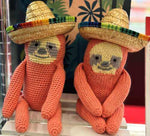*** Free UK delivery on orders over £75 ***
Menu
-
- New
-
Yarn
- Stitching
-
Hooks & Needles
-
Accessories
-
All Accessories
- Blocking
- Books and Magazines
- Buttons
- Cable Needles
- Chart Keepers
- Darning Needles and Pins
- Needle and Hook Cases
- Notebooks and Stationery
- Pom Poms
- Row Counters
- Rulers and Needle Gauges
- Scissors
- Sewing
- Stitch Holding Cords
- Stitch Markers
- Stitch Stoppers
- Swifts and Winders
- Wool Wash
- Yarn Bowls
- Yarn Snugs
- Other
- Bags
- Brands
-
All Accessories
-
Patterns & Kits
-
Gifts
- Sale
-
How to & Ideas
-
- Login

*** Free UK delivery on orders over £75 ***
What Is Sock Yarn?
February 25, 2022 5 min read

Contents
- What weight is sock yarn?
- What other types of sock yarn are there?
- What kind of yarn should I choose to knit my socks?
- What is self striping sock yarn?
- How much yarn do I need to make a pair of socks?
- What size crochet hook should I use for sock yarn?
- What size needle should I use for sock yarn?
What weight is sock yarn?
Sock yarn is a thin, fine yarn. After all, a pair of socks knitted with bulky wool wouldn't fit inside your shoes! Sock yarn is also sold under the name of 4ply. It is usually sold in balls or skeins of either 100g or 50g. To check that your yarn is the right weight, look at how many metres there are in the ball. 100g of sock yarn should be around 400m.Most yarn used for making socks is specifically labelled for this purpose. It is usually a blend of wool or merino with nylon for stability and elasticity. Generally, you will need 100g of sock yarn to make one pair of adult socks. Sock yarn is available in every colour you could imagine, and many knitters also use it to make lacy shawls, cowls, or other small projects.
What other types of sock yarn are there?
While 4ply sock yarn is by far the most common choice, and is the most practical wool for everyday socks, it's not the only option out there. There are reasons why you might want to make socks with thicker yarn. In winter, you might want thicker socks to wear under boots, for example. A very bulky yarn could also be suitable for a pair of house socks that you don't intend to wear with shoes. You might also choose to knit or crochet a pair of slippers from thicker yarn. These can be felted for additional coziness.If you're planning to knit a pair of socks with bulkier yarn, pay attention to ply. The higher the number, the thicker the yarn. Thick yarn will knit up faster, but think about how you plan to use the finished socks. Want to wear them under shoes? Then don't go for something that's too bulky!
What kind of yarn should I choose to knit my socks?
Hand-knitted socks can be extremely pretty, but they need to be practical, too! With that in mind, it's essential to choose a yarn that can stand up to the task. Check the label for the yarn's composition. Most sock yarn is a blend of approximately 75% wool or merino to 25% nylon. This nylon is essential, as it provides elasticity and stability on the heels and toes of your socks. If you're using them on a regular basis, pure wool socks will wear out quickly.Other fibres are not suitable for socks. For example, cotton easily stretches out of shape, so a pair of pure cotton socks will grow bigger and bigger during the day. Only choose cotton if it is blended with other fibres.
Most sock yarn is also superwash. This means that the wool has been treated so it can be washed in the washing machine. Choose a superwash sock yarn for a practical option. If not, you'll be stuck handwashing your socks! Superwash yarns are also less likely to pill, so your socks will look better for longer.
What is self striping sock yarn?
Self striping yarn can seem like a knitting miracle if you've never used it before! These yarns are made from a mix of colours that will become stripes as you knit them. Self striping yarns look particularly good with plain sock patterns, as intricate cables or lace can disappear in the colours. You can also look out for patterns written specifically for self striping yarns, which manipulate the stitches in interesting ways to create zig zags, diagonal stripes, and other effects.If you want perfectly matching socks, take care when you start your first sock. Pay attention to exactly where you are in the yarn's colour repeat, so you can start your second sock in the same place. You might prefer the unique fun of mismatched stripes, though - it will mean your socks are truly one of a kind!
How much yarn do I need to make a pair of socks?
Whether you're using standard sock yarn, or you want to make a thick pair of chunky wool socks to keep your toes toasty in winter, make sure you've got the right amount of yarn. Take a look at this sock knitting size chart for UK knitters to give you an idea:| Yarn Type | Man | Woman | Child |
|---|---|---|---|
| Yarn TypeSock Yarn (4ply) | Man400-600m | Woman400m | Child200-400m |
| Yarn TypeSock Yarn (6ply) | Man350-500m | Woman350m | Child300-350m |
| Yarn TypeDK Yarn (8ply) | Man300-350m | Woman250-300m | Child250m |
| Yarn TypeAran/Worsted Yarn (10ply) | Man250-400m | Woman200-250m | Child200m |
Remember, these are general recommendations. If your socks are for someone with big or small feet, you'll need to adjust accordingly. You'll also have to think about how long you want the socks to be. Most sock knitting patterns are designed to finish mid-calf.

What size crochet hook should I use for sock yarn?
When crocheting with sock yarn, you'll want to use a fine hook, between 2.25 and 3mm. If you're making socks, check your gauge before you start. A pair of socks should fit snugly, without being too tight to get on and off. If you're using a nice pair of sock yarn to crochet a lace shawl, or some other unfitted piece, then gauge is less important.What size needle should I use for sock yarn?
Most sock patterns are designed for fine needles, 2.25mm or 2.5mm. Check your gauge before you start. Socks should fit snugly. If they are too tight, they will be hard to get on and off; if they're too loose, they'll droop and fall down your legs as you go about your day.Most sock patterns are designed to be knitted in the round. This method creates a tube of knitted fabric. There's no long seam to sew up at the end, and your finished socks will be stronger and more durable than if they were knitted flat. To work in the round, you will either need double-pointed needles (known as DPNs), or a very long circular needle to work with the magic loop technique. This technique is a bit more advanced and can be hard to get used to, so newcomers to socks often prefer to stay with DPNs.
Double-pointed needles are sold in sets of four or five, and are ideal for knitting socks. You'll use one needle as the working needle, while the others hold the yarn, creating a tube shape that is impossible with regular needles. If you've never used them before, they can be fiddly at first, but with a bit of practice, they can be every bit as comfortable as working with two needles. Take particular care when casting on: if you twist the yarn, you'll have to start over again.
Also in Yarn Guides

What is boucle yarn?
March 21, 2025 2 min read
Boucle yarn is a popular material for knitting that creates a unique textured fabric. Learn everything you need to know about boucle with our in depth guide!

How to crochet a magic circle
May 19, 2023 4 min read

5% off your first order when you join our email newsletter...
Be the first to know of new product releases and other exciting news! A discount code will be sent to your email straight away!

